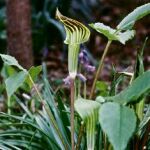| Common Name: |
Indian Turnip |
| Other Names: |
Jack-in-the-pulpit |
| Botanical Name: |
Arisaema triphyllum |
| Genus: |
Arisaema |
| Family: |
Araceae |
| Native Location: |
Eastern N America |
| Cultivation: |
Moist, well-drained, rich soil in dappled shade. Corms rot if too wet or cold. New foliage may be damaged by spring frosts. |
| Propagation: |
By seed sown in autumn or spring; by offset corms removed when dormant. |
| Harvest: |
Corms are lifted in autumn or in winter when plants are dormant, and dried for decoctions. |
| Height: |
15-60cm (6-12in) |
| Width: |
15-60cm (6-12in) |
| Hardiness: |
Z4-9 |
| Parts Used: |
Corms |
| Properties: |
An acrid, antiseptic herb that has expectorant effects and increases perspiration. |
| Medicinal Uses: |
Internally, a traditional native N American remedy for asthma, whooping cough, and bronchitis. Externally for rheumatism, boils and snakebite. Native people use dried aged roots, since these are less acrid but maintain their activity. The Pawnee and Hopi used dried, powdered roots, taken in water, as a contraceptive, inducing permanent sterility by increasing the dose and water temperature. |
| Culinary Uses: |
After slicing, drying, and storing to reduce acridity, corms yield a cocoa-flavored flour for baking. |
| Warning: |
All parts are hamful if eaten. Irritant to skin, eyes, and mucous membranes. |
| Bibliography: |
Encyclopedia of Herbs by Deni Brown Copyright © 1995, 2001 Dorling Kindersley Limited. pg 128 |

